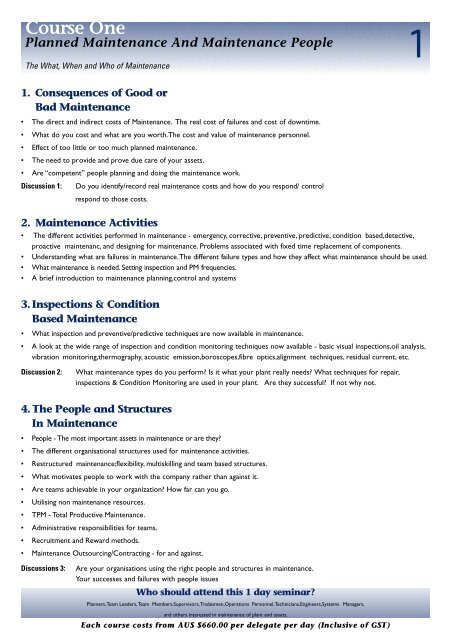April - Library
April - Library
April - Library
Create successful ePaper yourself
Turn your PDF publications into a flip-book with our unique Google optimized e-Paper software.
Course One<br />
Planned Maintenance And Maintenance People<br />
The What, When and Who of Maintenance<br />
1 . Consequences of Good or<br />
Bad Maintenance<br />
• The direct and indirect costs of Maintenance. The real cost of failures and cost of downtime.<br />
• What do you cost and what are you worth.The cost and value of maintenance personnel.<br />
• Effect of too little or too much planned maintenance.<br />
• The need to provide and prove due care of your assets.<br />
• Are “competent” people planning and doing the maintenance work.<br />
Discussion 1: Do you identify/re c o rd real maintenance costs and how do you respond/ control<br />
respond to those costs.<br />
Who should attend this 1 day seminar?<br />
Planners,Team Leaders,Team Members,Supervisors,Tradesmen,Operations Personnel,Technicians,Engineers,Systems Managers,<br />
and others interested in maintenance of plant and assets.<br />
Each course costs from AUS $660.00 per delegate per day (Inclusive of GST)<br />
1<br />
2 . Maintenance Activities<br />
• The different activities performed in maintenance - emergency, corrective, preventive, predictive, condition based,detective,<br />
proactive maintenanc, and designing for maintenance. Problems associated with fixed time replacement of components.<br />
• Understanding what are failures in maintenance.The diffe rent failure types and how they affect what maintenance should be used.<br />
• What maintenance is needed. Setting inspection and PM fre q u e n c i e s .<br />
• A brief introduction to maintenance planning,control and systems<br />
3 .Inspections & Condition<br />
Based Maintenance<br />
• What inspection and preventive/predictive techniques are now available in maintenance.<br />
• A look at the wide range of inspection and condition monitoring techniques now available - basic visual inspections,oil analysis,<br />
vibration monitoring,thermography, acoustic emission,boroscopes,fibre optics,alignment techniques, residual current, etc.<br />
Discussion 2: What maintenance types do you perform? Is it what your plant really needs? What techniques for repair,<br />
inspections & Condition Monitoring are used in your plant. Are they successful? If not why not.<br />
4 .The People and Stru c t u res<br />
In Maintenance<br />
• People - The most important assets in maintenance or are they ?<br />
• The different organisational structures used for maintenance activities.<br />
• Restructured maintenance;flexibility, multiskilling and team based structures.<br />
• What motivates people to work with the company rather than against it.<br />
• Are teams achievable in your organization? How far can you go.<br />
• Utilising non maintenance resources.<br />
• TPM - Total Productive Maintenance.<br />
• Administrative responsibilities for teams.<br />
• Recruitment and Reward methods.<br />
• Maintenance Outsourcing/Contracting - for and against.<br />
Discussions 3: Are your organisations using the right people and structures in maintenance.<br />
Your successes and failures with people issues
















